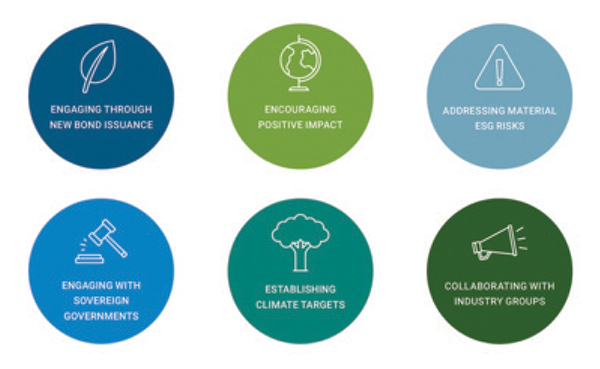Bonds: ESG into action

|
Written By: Scott Mather |
The current global health crisis underscores the importance of tapping capital markets to drive more sustainable development. PIMCO’s Scott Mather explains how the power of active engagement with bond issuers can move ESG from mere rhetoric into action
The current global health crisis underscores the importance of tapping capital markets to drive more sustainable development. As citizens of this world, it is important for fund management firms to engage in their areas of expertise to help drive change. Given that bond markets are significantly larger in value than equity markets, and the recurring nature of debt issuance to finance projects, fixed income investors are a meaningful force in driving sustainable change.
We believe in the power of active engagement with bond issuers to move ESG from mere rhetoric into action. Here are some recent examples of how we are bringing ESG into action through engagement:
Figure 1: How to bring ESG into action – six tools for ESG portfolios

Source: PIMCO. For illustrative purposes only.
1. Engaging through new bond issuance
- Case Study: An energy transition leader has demonstrated a clear focus on renewables and support of the science-based 2030 CO2 intensity target of 125g CO2/kWh by 2030 vs 369g in 2018.
- Engagement: PIMCO engaged with this company through the UN Global Compact (UNGC) for several years on their commitment to renewables and more recently through their participation in the UNGC symposium on SDG bonds – hosted at PIMCO’s Newport Beach offices to encourage companies to issue SDG-linked bonds.
- Outcome: At the end of 2019, the company issued a 5-year “General Purpose SDG-linked Bond” in US dollars (followed, later in the year, by a multi-tranche bond of the same type in euros) – a first-of-its-kind instrument where proceeds are used for general corporate purposes and future coupon payments are linked to their renewable growth strategy (25 basis point [bps] coupon step-up if targets are not achieved).
2. Encouraging positive impact
- Case Study: Indian solar energy producer with approximately 3.4 gigawatts (GW) in solar capacity considered financing project level debt with an additional green bond.
- Engagement: PIMCO engaged with the company prior to and after issuance to get a detailed breakdown of the use of proceeds, carbon emissions avoided and the carbon intensity of activities firm-wide. We also sought evidence that issuer had a broader sustainability strategy to mitigate risks related to environmental impact, biodiversity, business ethics, human capital, corporate governance and relationships with communities.
- Outcome: The company provided satisfactory responses to our questions, demonstrating a strong momentum in terms of integration of sustainability in its business strategy and corporate governance. We plan to continue engaging with the issuer following the publication of its sustainability report and green bond reporting.
3. Addressing material ESG risks
- Case Study: The Amazon fires in 2019 coupled with Brazil’s federal policy backdrop means heightened scrutiny and potentially higher ESG risks for this issuer (a meat producer), exposed to soft commodities sourcing, notably soy and cattle, that can be associated with deforestation in the Amazon basin.
- Engagement: We asked the issuer to clarify its stance on deforestation policies and sustainable sourcing policies, and encouraged the issuer to commit to ambitious public net deforestation policies and sustainable sourcing practices. In particular, we encouraged certification, traceability systems, and a resource footprint.
- Outcome: The company shared detailed information on its sustainability commitments, third party audits of suppliers, certification via geospatial verifications, and traceability. We followed up to share our expectations on climate change beyond Carbon Disclosure Project (CDP) disclosures, including the importance of setting a carbon emission reduction target covering its entire value chain.
4. Engaging with sovereign governments
- Case Study: A nation with a long history of political tension between the government and rebel forces. While significant social tensions persist, the government has been making progress on a resolution with the rebels as well as implementing a set of ambitious environmental commitments.
- Engagement: In our dialogues with the government, we have done our part to encourage them along their path to environmental sustainability. We have explained that as foreign investors, it is important to see progress on their stated sustainability goals and to thoughtfully balance the trade-offs between conservation policy and concurrent pushes for greater economic development that relies on extractive industries.
- Outcome: While there is opportunity for improvement on a number of key ESG factors, we are encouraged by the meaningful outcomes of their environmental sustainability agenda – they have emissions reduction and zero deforestation goals for 2030 and a carbon tax that has been in place since 2017, driving innovation in carbon pricing.
5. Establishing climate targets
- Case Study: An independent US power producer with a leading presence in the US residential market. While its installed capacity and energy mix are dominated by fossil fuels, notably gas and coal, it had not set a carbon emission reduction target or an advanced energy transition plan at the time of the release of its 2018 Sustainability report.
- Engagement: In the context of the CA100+ initiative, PIMCO co-led the engagement with the issuer along with other investors to encourage the company to set ambitious carbon emission reduction targets and align its disclosure with the TCFD recommendations.
- Outcome: The company unveiled a long-term carbon emission reduction target and fleshed out its climate governance and support for carbon pricing. We will continue to follow up regarding the opportunity for a more detailed climate risk disclosure and ambitious strategy in the future.
6. Collaborating with industry groups
- Example: UN Global Compact CFO Taskforce for the SDGs: Scott Mather, PIMCO CIO of US Core Strategies, in partnership with the UN Global Compact and energy utility ENEL, will co-chair this two-year project with the aim of mobilising hundreds of CFOs to tackle the financing needs around the SDGs.
These case studies bring to life our belief that active management is the responsible way to invest sustainably in fixed income.
For investment professionals only. PIMCO Europe Ltd (Company No. 2604517) Ltd (Company No. 2604517) and PIMCO Europe Ltd – Italy (Company No. 07533910969) are authorised and regulated by the Financial Conduct Authority (12 Endeavour Square, London E20 1JN) in the UK. PIMCO Europe Ltd services are available only to professional clients as defined in the Financial Conduct Authority’s Handbook and are not available to individual investors, who should not rely on this communication.
The above case studies are presented for illustrative purposes only, as a general example of PIMCO’s ESG research and engagement capability and are not intended to represent any specific portfolio’s performance or how a portfolio will be invested or allocated at any particular time. PIMCO’s ESG processes may yield different results than other investment managers and a company’s ESG rankings and factors may change over time. All data is as of 31 December 2019, unless otherwise stated.
More Related Content...
|
|
|